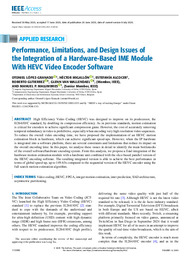Título :
Performance, limitations, and design issues of the
integration of a hardware-based IME module
with HEVC video encoder software |
Autor :
López Granado, Otoniel
Migallón, Héctor
Alcocer, Estefanía
Gutiérrez, Roberto
Van Wallendael, Glenn
Malumbres, Manuel |
Editor :
IEEE Access |
Departamento:
Departamentos de la UMH::Ingeniería de Computadores |
Fecha de publicación:
2025 |
URI :
https://hdl.handle.net/11000/36860 |
Resumen :
High Efficiency Video Coding (HEVC) was designed to improve on its predecessor, the
H264/AVC standard, by doubling its compression efficiency. As in previous standards, motion estimation
is critical for encoders to achieve significant compression gains. However, the cost of accurately removing
temporal redundancy in video is prohibitive, especially when encoding very high resolution video sequences.
To reduce the overall video encoding time, we have proposed the implementation of an HEVC motion
estimation block in hardware, which can achieve significant speed-ups. However, when the IP hardware
is integrated into a software platform, there are several constraints and limitations that reduce its impact on
the overall encoding time. In this paper, we analyse these issues in detail to identify the main bottlenecks
of the overall software/hardware encoding system. From this analysis, we propose a final integration of the
hardware motion estimation module with a hardware unit combined with the slice-based parallel version of
the HEVC encoding software. The resulting integrated version is able to achieve the best performance in
terms of global speed-up, up to 149.63x compared to the sequential version of the HEVC encoder using the
full search motion estimation algorithm.
|
Palabras clave/Materias:
Video coding
HEVC
FPGA
Integer motion estimation
Inter prediction
SAD architecture
Asymmetric partitioning |
Área de conocimiento :
CDU: Ciencias aplicadas: Ingeniería. Tecnología |
Tipo de documento :
info:eu-repo/semantics/article |
Derechos de acceso:
info:eu-repo/semantics/openAccess |
DOI :
10.1109/ACCESS.2025.3581961 |
Publicado en:
IEEE Access ( Volume: 13) |
Aparece en las colecciones:
Artículos Ingeniería de computadores
|
 La licencia se describe como: Atribución-NonComercial-NoDerivada 4.0 Internacional.
La licencia se describe como: Atribución-NonComercial-NoDerivada 4.0 Internacional.
.png)
